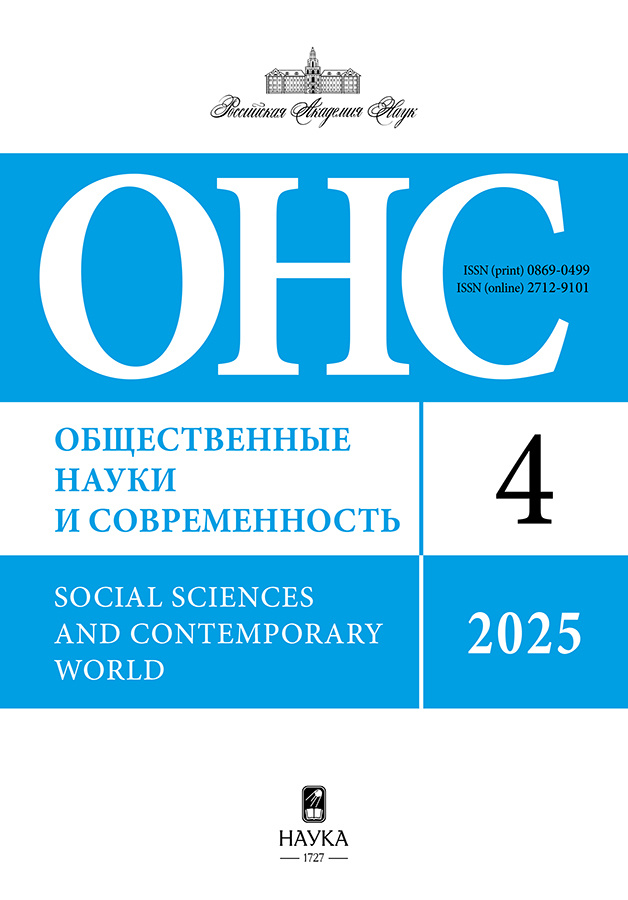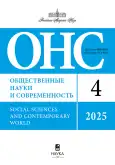Микроэкономика XXI века: новые возможности фундаментального анализа
- Авторы: РОЗАНОВА Н.М.1,2
-
Учреждения:
- Московская школа экономики МГУ имени М.В. Ломоносова
- МГИМО МИД России
- Выпуск: № 4 (2025)
- Страницы: 77-90
- Раздел: ЭКОНОМИЧЕСКИЕ ИССЛЕДОВАНИЯ
- URL: https://journal-vniispk.ru/0869-0499/article/view/323102
- DOI: https://doi.org/10.31857/S0869049925040063
- ID: 323102
Цитировать
Аннотация
С изменением экономической реальности меняется и представление о механизме принятия решений экономическими агентами на микроуровне. Рассмотрены ключевые тенденции в работах зарубежных исследователей в области микроэкономического анализа; продемонстрировано, как современная микроэкономика отражает изменения экономических условий. Проанализировано то новое, что вносят современные микроэкономические исследования и подходы в понимание сущности экономических явлений. Обобщены современные поведенческие предпосылки микроэкономики. В отношении потребителя проведен анализ нового понимания рациональности и иррациональности, замены максимизирующей цели на удовлетворенность; введены новые модели межвременного выбора с учетом межвременных трансакционных издержек; демонстрируется новый ключевой ограничитель выбора индивида – внимание и когнитивные ресурсы. В отношении фирмы показаны новые характеристики хозяйствующего субъекта как цифровой экосистемы, ведущие к стиранию граней между фирмой и рынком, между различными отраслями и сферами деятельности и в итоге – к трансформации классической фирмы в гибкое цифровое деловое предприятие. Продемонстрировано, что рыночные взаимодействия, ценовой механизм и конкурентные процессы в условиях информационной асимметрии приобретают новые характеристики.
Ключевые слова
Об авторах
Н. М. РОЗАНОВА
Московская школа экономики МГУ имени М.В. Ломоносова; МГИМО МИД России
Автор, ответственный за переписку.
Email: happyeconomics@list.ru
Москва, Россия; Москва, Россия
Список литературы
- Acemoglu, D., & Jackson, M. (2017). Social norma and the enforcement of laws. Journal of European Economic Association. Vol. 15. No. 2. Pp. 245–295.
- Ali, N., & Benabou, R. (2020). Image versus information. American Economic Journal: Microeconomics. Vol. 12. No. 3. Pp. 116–164.
- Apesteguia, J., Ballester, M., & Cuhadaroglu, T. (2023). A behavioral model of adaptation. Journal of Economic Behavior and Organization. Vol. 207. Pp. 146–156.
- Arcidiacono, P., Ellickson, P., Mela, C., & Singleton, J. (2020). The competitive effects of entry. American Economic Journal: Applied Economics. Vol. 12. No. 3. Pp. 175–206.
- Arrow, K., Bilir, K., & Sorensen, A. (2020). The impact of information technology on the diffusion of new pharmaceuticals. American Economic Journal: Applied Economics. Vol. 12. No. 3. Pp. 1–39.
- Asheim, B. (2018). Smart specialisation, innovation policy and regional innovation systems: what about new path development in less innovative regions? The European Journal of Social Science Research. Vol. 32. No. 1. Pp. 1–18.
- Baldwin, C., Bogers, M., Kapoor, R., & West, J. (2024). Focusing the ecosystem lens on innovation studies. Research Policy. Vol. 53. No. 104949. https://doi.org/10.1016/j.respol.2023.104949
- Biglaiser, G., & Cremer, J. (2020). The value of incumbency when platforms face heterogeneous customers. American Economic Journal: Microeconomic. Vol. 12. No. 4. Pp. 229–269.
- Billot, A., Mukerji, S., & Tallon, J-M. (2020). Market allocations under ambiguity. Revue Economique. Vol. 71. No. 2. Pp. 267–282.
- Braunerhjelm, P., & Lappi, E. (2023). Employees’ entrepreneurial human capital and firm performance. Research Policy. Vol. 52. No. 104703. https://doi.org/10.1016/j.respol.2022.104703
- Campbell, A., Leister, C.M., & Zenou, Y. (2020). Word-of-mouth communication and search. The RAND Journal of Economics. Vol. 51. No. 3. Pp. 676–712.
- Chandrasakhar, A., Larreguy, H., & Xandri, J.P. (2020). Testing models of social learning on networks. Econometrica. Vol. 88. No. 1. Pp. 1–32.
- Cohen, J., Ericson, K.M., Laibson, D., & Myles, J. (2020). Measuring time preferences. Journal of Economic Literature. Vol. 58. No. 2. Pp. 299–347.
- Echenique, F., Imai, T., & Saito, K. (2020). Testable implications of models of intertemporal choice. American Economic Journal: Microeconomics. Vol. 12. No. 4. Pp. 114–143.
- Eliaz, K., & Spiegler, R. (2020). Incentive-compatible advertising on nonretail platforms. The RAND Journal of Economics. Vol. 51. No. 2. Pp. 323–345.
- Ellickson, P., Grieco, P., & Khvastunov, O. (2020). Measuring competition in spatial retail. The RAND Journal of Economics. Vol. 51. No. 1. Pp. 189–232.
- Espana, V., Aparicio, J., Barber, X., & Esteve, M. (2024). Estimating production functions through additive models based on regression splines. European Journal of Operational Research. Vol. 312. No. 2. Pp. 684–699.
- Filippas, A., Horton, J., & Golden, J. (2019). Reputation inflation. NBER Working paper 25857. May. http://www.nber.org/papers/w25857
- Fischer, P., Heinle, M., & Smith, K. (2020). Constrained listening, audience alignment, and expert communication. The RAND Journal of Economics. Vol. 51. No. 4. Pp. 1037–1062.
- Francke, A.E., & Carrete, L. (2023). Consumer self-regulation: looking back to look forward. A systematic literature review. Journal of Business Research. Vol. 157. No. 113461. https://doi.org/10.1016/j.jbusres.2022.113461
- Frankel, A., & Kartik, N. (2019). Muddled information. Journal of Political Economy. Vol. 127. No. 4. Pp. 1739–1776.
- Galeotti, A., Golub, B., & Goyal, S. (2020). Targeting interventions in networks. Econometrica. Vol. 88. No. 6. Pp. 2445–2471.
- Halac, M., & Kremer, I. (2020). Experimenting with career concerns. American Economic Journal: Microeconomics. Vol. 12. No. 1. Pp. 260–288.
- Hanany, E., Klibanoff, P., & Mukerji, S. (2020). Incomplete information games with ambiguity averse players. American Economic Journal: Microeconomics. Vol. 12. No. 2. Pp. 135–187.
- Hashimzade, N., Kirsanov, O., & Kirsanova, T. (2023). Distributional effects of endogenous discounting. Mathematical Social Science. Vol. 122. Pp. 1–6.
- Herskovic, B., & Ramos J. (2020). Acquiring information through peers. The American Economic Review. Vol. 110. No. 7. Pp. 2128–2152.
- Huang, Y., Li, K., & Li, P. (2023). Innovation ecosystems and national talent competitiveness: a country-based comparison using fsQCA. Technological Forecasting and Social Change. Vol. 194. Issue. 4. No. 22733. https://doi.org/10.1016/j.techfore.2023.122733
- Jacobides, M., Cennamo, C., & Gawer, A. (2024). Externalities and complementarities in platforms and ecosystems: from structural solutions to endogenous failures. Research Policy. Vol. 53. No. 104906. https://doi.org/10.1016/j.respol.2023.104906
- Kamada, Y., & Kandori, M. (2020). Revision Games, Econometrica Vol. 88. No. 4. Pp. 1599–1630.
- Kuersteiner, G., & Prucha, I. (2020). Dynamic Spatial Panel Models. Econometrica. Vol. 88. No. 5. Pp. 2109–2146.
- Li, L., Tadelis, S., & Zhou, X. (2020). Buying reputation as a signal of quality: evidence from an online marketplace. The RAND Journal of Economics. Vol. 51. No. 4. Pp. 965–988.
- Linde, J., Gietl, D., Sonnemans, J., & Tuinstra, J. (2023). The effects of quantity and quality of information in strategy tournaments. Journal of Economic Behavior and Organization. Vol. 211. Pp. 305–323.
- Mauring, E. (2020). Informational cycles in search markets. American Economic Journal: Microeconomics. Vol. 12. No. 4. Pp. 170–192.
- Mullainathan, S. (2020). A memory-based model of bounded rationality. The Quarterly Journal of Economics. Vol. 117. No. 3. Pp. 735–774.
- Okuyama, R., & Tsujimoto, M. (2020). The importance of drug target selection capability for new drug innovation: definition, fostering process, and interaction with organizational management. Prometheus. Vol. 36. No. 2. Pp. 135–152.
- Paz, M.D.R., & Vargas, J.C.R. (2023). Main theoretical consumer behavioral models. A review from 1935 to 2021. Heliyon. Vol. 9. No. e13895. https://doi.org/10.1016/j.heliyon.2023.e.13895
- Shomalzadeh, K., Scherpen, J., & Camlibel M.K. (2023). A real-time balancing market optimization with personalized prices: from bilevel to convex. Operations Research Perspectives. Vol. 10. No. 100276. https://doi.org/10.1016/j.orp. 2023.100276
- Silva, F. (2020). The importance of commitment power in games with imperfect evidence. American Economic Journal: Microeconomics. Vol. 12. No. 4. Pp. 99–113.
- Sjodin, D., Liljeborg, A., & Mutter, S. (2024). Conceptualizing ecosystem management capabilities: managing the ecosystem-organization interface. Technological Forecasting & Social Change. Vol. 200. No. 123187. https://doi.org/10.1016/j.techfore.2023.123187
- Stornelli, A., Simms, Ch., Reim, W., & Ozcan, S. (2024). Exploring the dynamic capabilities of technology provider ecosystems: a study of smart manufacturing projects. Technovation. Vol. 130. No. 102925. https://doi.org/10.1016/j.technovation.2023.102925
- Sweeting, A., Jia, D., Hui, S., & Yao, X. (2020). Dynamic price competition, learning-by-doing and strategic buyers. NBER Working Paper 28272. December. http://www.bver.org/papers/w28272
- Wilson, A., & Vespa, E. (2020). Information transmission under the shadow of the future. American Economic Journal: Microeconomics. Vol. 12. No. 4. Pp. 75–98.
- Xie, X., Liu, X., & Blanco, C. (2023). Evaluating and forecasting the niche fitness of regional innovation ecosystems: a comparative evaluation of different optimized grey models. Technological Forecasting and Social Change. Vol. 191. Issue 4. No. 122473. https://doi.org/10.1016/j.techfore.2023.122473
- Zervas, G., Proserpio, D., & John, B. (2021). A First look at online reputation on Airbnb, where every stay is above average. Marketing Letters. Vol. 32. No. 1. Pp. 1–16.
Дополнительные файлы










